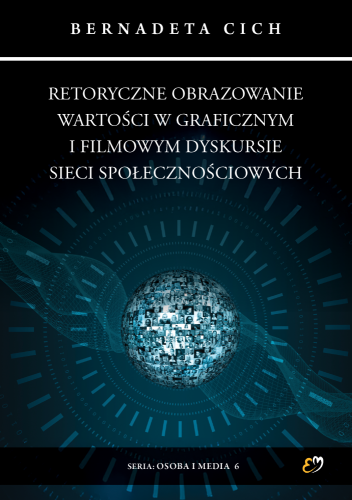Retoryczne obrazowanie wartości w graficznym i filmowym dyskursie sieci społecznościowych
Schlagworte:
obraz, wartości, komunikacja, retoryka obrazu, retoryka wizualna, etyka, etyka obrazu, retoryka filmu, imaginarium, obrazowanie, visual valor, sieć społecznościowa, memÜber dieses Buch
Rozwój cyfrowy pociąga za sobą intensyfikację komunikacji, którą można określić jako okulocentryczną. Komunikacja za pomocą obrazów jako komunikatów czy – mówiąc bardziej ogólnie – form obrazowych znana jest od czasów prehistorycznych. Jednak przejawy obrazowej komunikacji w konkretnych jej artefaktach są dość oszczędne i bardziej dotyczą obrazów artystycznych niż tych, które są użytkowe, pozbawione funkcji estetycznych na rzecz informacyjnych czy emocjonalnych. Język natomiast jako system znaków werbalnych był do tej pory głównym narzędziem komunikacji i jemu poświęcone są teorie naukowe, które tym samym przyznają sferze werbalnej rolę pierwszoplanową. Niemniej w ludzkiej komunikacji obraz był obecny jako właściwość ludzkiej natury, a stopień jego uczestnictwa i sposób działania jest wciąż badany. W tym kontekście można umiejscowić problemy związane z myśleniem obrazami oraz ich korelacją z językiem, a co najważniejsze – ich stopniem determinowania poglądów, postaw i ludzkich działań. W tej przestrzeni i za sprawą rozwoju możliwości tworzenia, nadawania i odbierania form wizualnych pojawił się – lub inaczej – znalazł swoje miejsce i możliwość materialnej realizacji w postaci cyfrowych obrazów etyczny dyskurs. To krótkie filmy i grafiki, których główną i wyraźną funkcją jest przejawianie wartości przez ukazanie ludzkich postaw. Pierwsze świadome zauważenie tych artefaktów medialnych i spojrzenie na nie przez pryzmat dorobku literatury, filozofii, psychologii czy historii komunikacji pozwoliło na zauważenie pewnego fenomenu komunikacyjnego. Z pewnością naturą zaobserwowanych materiałów o funkcji etycznej jest przekonywanie do danych postaw w procesie przebudowy imaginarium z zaangażowaniem emocji. Zatem celem procesu badawczego jest zidentyfikowanie przedmiotu badania, określenie jego cech charakterystycznych przez pryzmat gatunków, poszukiwanie analogii i prawidłowości oraz sposobu oddziaływania w strukturze dyskursu sieci społecznościowej.



